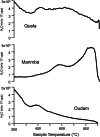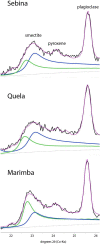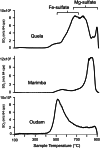Evidence for Multiple Diagenetic Episodes in Ancient Fluvial-Lacustrine Sedimentary Rocks in Gale Crater, Mars
- PMID: 32999799
- PMCID: PMC7507756
- DOI: 10.1029/2019JE006295
Evidence for Multiple Diagenetic Episodes in Ancient Fluvial-Lacustrine Sedimentary Rocks in Gale Crater, Mars
Abstract
The Curiosity rover's exploration of rocks and soils in Gale crater has provided diverse geochemical and mineralogical data sets, underscoring the complex geological history of the region. We report the crystalline, clay mineral, and amorphous phase distributions of four Gale crater rocks from an 80-m stratigraphic interval. The mineralogy of the four samples is strongly influenced by aqueous alteration processes, including variations in water chemistries, redox, pH, and temperature. Localized hydrothermal events are evidenced by gray hematite and maturation of amorphous SiO2 to opal-CT. Low-temperature diagenetic events are associated with fluctuating lake levels, evaporative events, and groundwater infiltration. Among all mudstones analyzed in Gale crater, the diversity in diagenetic processes is primarily captured by the mineralogy and X-ray amorphous chemistry of the drilled rocks. Variations indicate a transition from magnetite to hematite and an increase in matrix-associated sulfates suggesting intensifying influence from oxic, diagenetic fluids upsection. Furthermore, diagenetic fluid pathways are shown to be strongly affected by unconformities and sedimentary transitions, as evidenced by the intensity of alteration inferred from the mineralogy of sediments sampled adjacent to stratigraphic contacts.
Keywords: Mars; XRD; diagenesis; mineralogy.
©2020. The Authors.
Figures










References
-
- Abramov, O. , & Kring, D. A. (2005). Impact‐induced hydrothermal activity on early Mars. Journal of Geophysical Research, 110(E12), 10.1029/2005je002453 - DOI
-
- Anderson, R. , Jandura, L. , Okon, A. , Sunshine, D. , Roumeliotis, C. , Beegle, L. , Hurowitz, J. , Kennedy, B. , Limonadi, D. , McCloskey, S. , Robinson, M. , Seybold, C. , & Brown, K. (2012). Collecting samples in Gale crater, Mars; an overview of the Mars Science Laboratory sample acquisition, sample processing and handling system. Space Science Reviews, 170(1–4), 57–75. 10.1007/s11214-012-9898-9 - DOI
-
- Archer, P. D. , Ming, D. W. , & Sutter, B. (2013). The effects of instrument parameters and sample properties on thermal decomposition: Interpreting thermal analysis data from Mars. Planetary Science, 2(1), 2 10.1186/2191-2521-2-2 - DOI
-
- Badaut, D. , Decarreau, A. , & Besson, G. (1992). Ferripyrophyllite and related Fe3+‐rich 2:1 clays in recent deposits of Atlantis II Deep, Red Sea. Clay Minerals, 27(2), 227–244. 10.1180/claymin.1992.027.2.07 - DOI
-
- Bergmann, J. , & Kleeberg, R. (1998). Rietveld analysis of disordered layer silicates In Materials Science Forum (Vol. 278, pp. 300–305). Switzerland: Trans Tech Publications.
LinkOut - more resources
Full Text Sources
Miscellaneous
